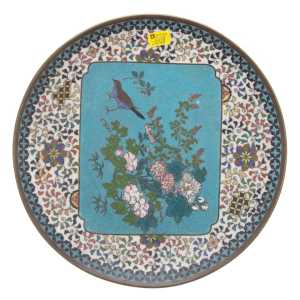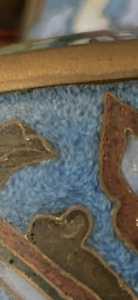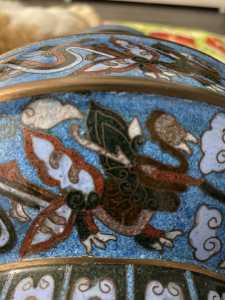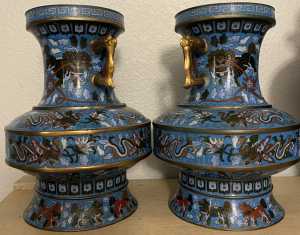The Chinese and Asian Art Forum. For Fans, Collectors and Dealers.
 Basic Rules For the BidAmount Asian Art Forum: Talk about whatever you want. You can even discuss and offer things that are for sale if they are authentic. Maximum image file size per post is 2 MB. Images of 700pxl x 700pxl are optimal if saved at a medium resolution. Be respectful of others and enjoy yourself. Click the YouTube link for a brief tutorial on using the forum. You can also EMBED Videos by cutting and pasting from You-Tube, Vimeo etc.
Basic Rules For the BidAmount Asian Art Forum: Talk about whatever you want. You can even discuss and offer things that are for sale if they are authentic. Maximum image file size per post is 2 MB. Images of 700pxl x 700pxl are optimal if saved at a medium resolution. Be respectful of others and enjoy yourself. Click the YouTube link for a brief tutorial on using the forum. You can also EMBED Videos by cutting and pasting from You-Tube, Vimeo etc.
NOTE: To post an item or add a new post, click open the category title from the FORUM LIST, and CLICK the Blue ADD TOPIC button.
@lucky LOL!
If I'm wrong, I pay the fee...okay. But if I am right, and I am confident that I am right, what do I get? The pride of knowing I was right? Too little, in this case.
I say, save your money on this one... you don't need Peter's help. There is little doubt that the vases are post 1950, whether you think they are Chinese or Japanese, and most likey 1980's from what I see given the heavy form, thick wire, dull colors, and wide spacing of wire work.
If you can accept the dating, then you must accept that they are Chinese. The Japanese do not make 'Chinese' style cloisonne after circa 1900. What the Japanese continue to make since the beginning of the 20th c. is mostly open work (in the manner of Ando), and some with the 'goldstone' style with dense geometricly designs.
Still want to ask Peter?
How about this? If I'm right, if you post in this forum a really good piece that I want to buy, no matter the true value, you'll sell it to me for what you paid for it? I'll even pay the shipping!
@greeno107 I would agree just in 1 case that's Chinese - should be fairly new vases, and that Chinese man made then in "what ever" style and what ever how. But these vases definitely have some age. I am completely away from cloisonné word, in last 3 years I did purchase 2 cloisonné items. One vase was mid 20c and other item bowl was 19th century, both Chinese - so my knowledge about cloisonné wares super little close to zero and this is not what I am looking forward to purchase.
I remember I had a Japanese footed shallow tray from the Meiji period, before establishing full understanding in that item, I was confident that's Chinese made tray. Some of the decoration, was identical when compared to the vases and the blue enamel was identical.
What you will get - well you will get - me loosing 12 bucks & you will gain additional respect from the forum member in regards to cloisonné knowledge when it comes to the odd cloisonné wares. This is not live or die, this is not to prove who is better or worse, this is no about to prove that you or me wrong - you response sounded 100% confident, but just based on you personal thoughts, with no real firm grounds what will prove that's Chinese for sure. I really have doubts, based on my previous experience long time ago which is mentioned above, nothing else.
No disrespect in anyway!
@lucky No disrespect in anyway!
None taken. And, if you feel better to ask Peter, please ask. I'm not concerned of any loss of reputation if he should agree with you - like all of us, Peter has made some errors in evaluating pieces, so since I'm equally human, I think I can afford to be wrong once in a while.
However, I recall two times that Peter has told people who have posted here in the Forum that their cloisonne piece was modern. And, when I offered to buy the pieces (because in both cases they were really quite nice/old Chinese pieces), the owners declined and later found their pieces to be valuable.
It happens to everyone.
In the case of these two vases, I disagree that they have 'age'. What I see is poor craftsmanship and inferior materials, which sometimes makes a piece look 'old'.
This is not the method that Japanese makers employ when making cloisonne. Even modern Japanese pieces are carefully made, and generally with very good material (often silver wire). Japanese wares that emulate Chinese designs from the late 19th c. / early 20th c. use different colors than what is shown on these vases.
Here is an example of a Japanese cloisonne charger from the late 19th/early 20th c. with a semi-Chinese design and wire method.
Sometimes these type of pieces don't have the obvious 'bird & flower' type panel that gives away the fact the piece is Japanese, so on occassions, this type of wares are mistaken as Chinese Ming style cloisonne (especially if they have a blue ground). However, the wire work is different, and the colors are quite different than what the Chinese were using.
I suggest you go to Ebay, and search for 'cloisonne vase', but refine your search to just pieces coming from China. I think you'll find some very similar pieces, and as you know, the pieces from China are modern since genuine antiques are not permitted to be shipped outside of China.
Here are a few examples that share similar color and wire work...
Now, do the same search for 'japanese cloisonne vase', but you can search the entire world if you like.
You should see how different the rending is, how much more refined both antique, vintage, and modern examples really are compared to the vases shown by Brian.
As for your bet, it's a fun notion, but it does not actually prove anything by betting. The proof is in the research.... go do your homework for yourself, don't rely on the 'expert's opinion' by itself, and feel free to prove me wrong if you can.
Good luck!
@greeno107 The vase which is listed at 65k - pure chinese. 2nd one, is Japanese, listed as Chinese
Off topic - I am expecting 1 porcelain plate, still not have it on hands, but in real I can't understand what is it in real. Is it Japanese or Chinese maybe for Japanese market. I will post pictures later for a discussion. Really odd looking plate in regards decoration.
I don't know if anyone looked at my post, but the link showed a similar pair of vases, described as possibly Qianlong, but they didn't sell. Given this was an easily accessible online auction, I am sure that had they had some age or value they would have sold.
@lucky The second which you say is Japanese, which I believe is the one listed for $488 with foo dogs, has a Qianlong mark. The Japanese copied Ming marks on some late 19th c./early 20th c. Ming-style cloisonne, but NEVER Qianlong marks. This vase is Chinese, and a modern copy to fool buyers into thinking it is circa 1900.
I thought I will let "this one go" without paying a fee to Peter...But I feel a little bit forced to do so 🙂 I am paying, but incase it's Japanese, you are refunding me..But issue is, now there are 2 subjects instead of 1 🙂 Not positive sure how to deal with this now.@lucky The second which you say is Japanese, which I believe is the one listed for $488 with foo dogs, has a Qianlong mark. The Japanese copied Ming marks on some late 19th c./early 20th c. Ming-style cloisonne, but NEVER Qianlong marks. This vase is Chinese, and a modern copy to fool buyers into thinking it is circa 1900.
greeno107 Tim I strongly disagree with you on the the pieces not being quality craftsmanship and poor materials I have owned a lot of cloisonné and still own a lot of Cloisonné the craftsmanship of this pieces is actually very high these pieces have no miss alignment not one area has has enamel spilling out of the intended area. No raising of any wire. As for age and origin I have to ask everyone in this forum which I know everyone here has seen alot of cloisonné has anyone here ever seen a cloisonné where all of the enamels are blended because if you have I would love to see it. Every book and even an expert has told me personally that blending enamels is extremely difficult to fire and to control in the kilns it is very time consuming and takes more firing and stages. Also the construction of these are pretty complex many layers and joints. This is just my opinion you see in this photo how the enamels are blended making it look like water flowing making waves against the shore please show me one that looks fluid like this.
One other thing to remember this was don’t on two vases in reverse almost to the T in complex wiring technique and they are identical spacing size and motion say these are modern as all believe this means a new technique in blending has occurred but I have seen similar blending techniques twice It was on Meiji cloisonné and Qainlong imperial Cloisonné. I’m not suggesting these are imperial I just stating that I have not seen and modern piece today like these two vases so all opinions are without merit.
@lotusblack Brian, I am sure if someone knew what it is exactly and when your vases are made - there would be a response from someone. Julia earlier posted interestingly looking vases. I did looked up at them, well it's an auction house. Can they be trusted in this case? Don't know. They even don't have a separate Asian art section, looks like that they they sell whatever they can sell, and no-one knows what kind of expertise they have when it comes to Asian object over there. This is my personal opinion. Still there is a chance that I will end up paying 12 bucks to Peter after all, to get an opinion. But I look at this as - I have no issues to sacrifice few bucks for a good and nice member as yourself 👍 I am leaning towards Japan. Other vase which is $488 on eBay, 100% Japanese cloisonné incorrectly listed. Maybe Peter will be kind enough to resolve this mystery here, within this thread?
The only thing I know for sure is that I can't find an example online of a mirrored pair in this antique style. There are the ones that Julia found but they are not exactly the same style. That could be a good sign or a bad sign, but in any case, I like them very much.
@sharonp I feel like the investigative part is sometime as fun and the purchasing part. I paid a very fare price for the pair at almost 13 inches tall I can resell at a profit easily even modern Cloisonné at current retail market can be expensive there is a lot of work involved in making these. The government controls the quality right now and I expect some amazing pieces in a 100 years someone will kill for these. I still leaning republic until ai find something similar
I don't think I understand what you mean by blended.
In the close up, there was a look of Japanese enamels - the goldstone type. I know it can be frustrating when you feel sure of something and others can't see it, but as you know, it is so much easier when you can hold something in your hand rather than relying on photos.
@julia blended is the use of several colors in a wired area almost like speckles of different shades of blue green red etc. There is no primary shade.
Thanks for visiting "The BidAmount Asian Art Forum | Chinese Art"
If you sell on eBay, or have a shop feel free to post images and descriptions and links.
Check back often for discussion about the latest news in the Chinese art and antique world. Also find out about the latest Asian art auctions at Sotheby's, Christie's, Bonhams and Tajans.
Auction results for: fine porcelain, ceramics, bronze, jade, textiles and scholar's objects. As well as Japanese, Thai, Vietnamese and other Asian cultures.
Thank you,
Peter Combs
Topics and categories on The BidAmount Asian Art Forum | Chinese Art
Kangxi vases, Kangxi dishes and chargers, Kangxi ritual pieces, Kangxi scholar's objects, Qianlong famille rose, Qianlong enamels, Qianlong period paintings, Qianlong Emporer's court, Fine porcelain of the Yongzheng period. Chinese imperial art, Ming porcelain including Jiajing, Wanli, Xuande, Chenghua as well as Ming jades and bronzes.
The BidAmount Asian Art Forum | Chinese Art
A free Asian art discussion board and Asian art message board for dealers and collectors of art and antiques from China, Japan, Korea, Thailand, Cambodia, Vietnam and the rest of Asia. Linked to all of the BidAmount Asian art reference areas, with videos from plcombs Asian Art and Bidamount on YouTube. Sign up also for the weekly BidAmount newsletter and catalogs of active eBay listing of Chinese porcelain, bronze, jades, robes, and paintings.
The art of calligraphy - and for the ancient Chinese it certainly was an art - aimed to demonstrate superior control and skill using brush and ink. Calligraphy established itself as one of the major Chinese art forms during the Han dynasty (206 BCE - 220 CE), and for two millennia after, all educated men were expected to be proficient at it.
The Museum’s collections of Asian art span nearly five millennia and encompass the cultures of China, the Himalayas, India, Japan, Korea, and Southeast Asia. In 2007, the Museum launched an initiative to create dedicated galleries for the collection, beginning with a gallery for the arts of Korea ...
Chinese art is full of symbolism, in that artists typically seek to depict some aspect of a totality of which they are intuitively aware.
China Online Museum is the finest online museum of Chinese art. It features Chinese calligraphy, painting, ceramics, bronzes, carving, and other artworks.
Chinese Ceramics & Works of Art. Overview Upcoming auctions Contacts Auction results ... Christie’s sales of Chinese ceramics and works of art showcase centuries of Chinese history. Held throughout the year in London, New York, Paris and Hong Kong, they attract a wide audience of collectors and connoisseurs vying for pieces as diverse as ...
Explore Asian Art Week. Contact the Specialist Department. Chinese Paintings ... Senior Specialist, Head of Sale. [email protected]. Tel:+1 212 641 5760. Bid in-person or online for the upcoming auction:Fine Chinese Paintings on 10 September 2019 at New York. Bid in-person or online for the upcoming auction:Fine Chinese Paintings on 10 ...
Discover an abundance of must-see art from all corners of a vast continent at Christie’s NY Asian Art Week. From contemporary classical and Chinese paintings to works with exemplary provenance from the Art Institute of Chicago, our Rockefeller Paza galleries will be full of ancient treasures and contemporary masterworks in a salute to the vibrant arts of Asia.
Sold to benefit The Art Institute of Chicago’s Asian Art Acquisition Fund, the sale features 84 lots with a focus on Ming and Qing porcelains, and offers a rare insight into the taste for collecting Chinese ceramics and works of art in the Midwest from the end of the 19th century through the 1980s. Highlights include two Wanli wucai garlic-head vases, a Qianlong mark and period, blue and ...
Specialist, Chinese Paintings, Christie's London Dr Malcolm McNeill is a Specialist in Chinese Paintings at Christie’s, based in London. He previously worked as an assistant curator of the Chinese collections and the Victoria and Albert Museum in London, as a researcher at the British Museum, and as a translator and tour guide at the National Palace Museum in Taipei.
The Christie's Education 2020 Conference: The Chinese Art Market 18 Jun 2019 Christie’s Education is delighted to announce our first international academic conference in Asia which will take place in Hong Kong from 26-27 November 2020 at the Hong Kong Convention and Exhibition Centre and will run in parallel with Christie’s Hong Kong Autumn Auctions.
The summer Chinese Art sale in Hong Kong will feature works of art from several private collections, including Qing porcelains and textile from the collection of the legendary Chinese art dealer A. W. Bahr (1877–1959), fine gilt bronze Buddhist sculptures from an old Hong Kong collection, an East Asian collection of Qing dynasty wine cups and jades, and a Japanese collection of Song ceramics ...
Sotheby's Chinese Works of Art Department holds two auctions each year in London, New York, Hong Kong and Paris.
Chinese Art - View Auction details, bid, buy and collect the various artworks at Sothebys Art Auction House.
With more than 340 Chinese works of art dating from the Neolithic to the Republic periods, highlights of this sale include a selection of Qing Imperial monochromes from the collection of Arnold and Blema Steinberg, early ceramics from the Art Institute of Chicago and Chinese porcelain and works of art from the collection of Henry Arnhold.
Results: Sotheby's Asia Week achieved $52.4 million in six strong auctions, exceeding pre-sale estimates. With 76.5% of lots sold and 60.3% of lots surpassing high estimates, the Asian art sales at Sotheby's indicate continued collector interest in the finest works of art from China, India and and the Himalayas.
Today's sale of Important Chinese Art will proceed as planned with sessions at 10 AM and 2 PM EDT. Sotheby's will be monitoring the weather conditions throughout the day and will be available to coordinate alternative bidding options should conditions make it difficult for clients to attend the auction in person.
Bonhams Chinese Art department is renowned for offering the finest works of art representing the richness and breadth of China's artistic heritage, particularly Imperial porcelain, white and spinach green jades, cloisonné and Buddhist art. Specialised international auctions are held globally, including London, Hong Kong and San Francisco.
Bonhams : Chinese Works of Art We use cookies to remember choices you make on functionality and personal features to enhance your experience to our site. By continuing to use our site you consent to the use of cookies. Please refer to our privacy and cookie policies for more information.
Bonhams Fine Art Auctioneers & Valuers: auctioneers of art, pictures, collectables and motor cars. We use cookies to remember choices you make on functionality and personal features to enhance your experience to our site. By continuing to use our site you consent to the use of cookies. ... Chinese Art (US) General enquiries
Bonhams : Fine Chinese Art We use cookies to remember choices you make on functionality and personal features to enhance your experience to our site. By continuing to use our site you consent to the use of cookies. Please refer to our privacy and cookie policies for more information.
Bonhams Fine Art Auctioneers & Valuers: auctioneers of art, pictures, collectables and motor cars Bonhams : Asian Art We use cookies to remember choices you make on functionality and personal features to enhance your experience to our site.
Bonhams are international auctioneers of fine Chinese and Japanese art. We specialise in rare Imperial and Export Chinese ceramics and works of art, as well as Japanese ceramics, fine and decorative works of art from the Neolithic Period to the 20th century. View on map
Bonhams Fine Art Auctioneers & Valuers: auctioneers of art, pictures, collectables and motor cars. We use cookies to remember choices you make on functionality and personal features to enhance your experience to our site. By continuing to use our site you consent to the use of cookies. ... Asian Art Bonhams. Work. 22 Queen St.




